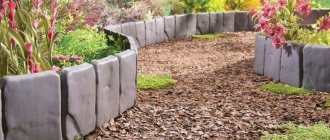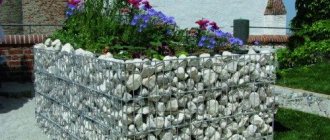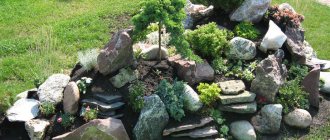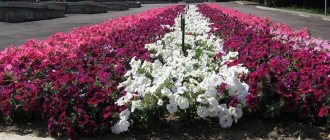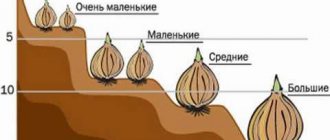What is decorative crushed stone
Granular material for landscape decoration is obtained after processing rock. The raw materials are not afraid of low temperatures, resistant to sunlight and chemicals. By origin, decorative crushed stone can be primary (from natural stone) and secondary (from construction residues).
The beauty of the landscape depends on the material from which the decoration was created. Among the popular options, designers note 6 types:
- Marble. Durable stones with an uneven, original pattern. The color palette ranges from white and yellow to blue and rich black.
- Granite. Beautiful raw materials interspersed with quartz. It comes in gray and red. Oxidizes soil and water.
- Coil. The practical material is available in all shades of green.
- Sandstone. Budget option of medium strength. Brown, brick and yellow colors are popular.
- Quartz. The translucent beautiful stone can be smoky, milky and golden.
- Limestone. The material has low strength, but an affordable price. The tint palette is white, ash and brown with light veins. Alkalizes the soil of the site.
Designer gravel in a flower bed Source rusolymp.ru
The shape of decorative crushed stone depends on the tasks that the decoration performs. Flat, smooth elements are used for pedestrian areas and the arrangement of artificial reservoirs. Universal cubic ones will help create any design of the site. Inexpensive cone-shaped and trapezoidal options are used for flower beds.
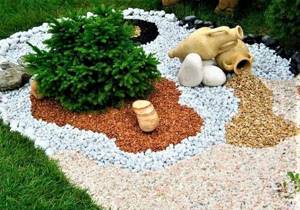
Varieties of decorative powder Source sad-dvorik.3dn.ru
The decorative material allows moisture to pass through well, but does not allow water to evaporate. Graveled dirt paths do not get wet after rain. When decorating flower beds and beds, weeds do not sprout in empty areas, which allows minimizing the physical effort of care.

Decorative flowerbed with crushed stone Source mirmulchi.ru
Video: Geotextiles in a flowerbed

Organic filling
Organic bulk materials include crushed structures of natural origin, such as:
- Woodchips.
- Needles.
- Pine nut shell.
- Bark of large and small fractions (pine, oak, cedar, etc.).
- Conifer cones (whole or crushed).
- Sawdust and shavings.
- Peat and compost.
- Husks of cedar cones.
- Straw.
Natural bulk decor is painted with environmentally friendly paints of a wide variety of colors, which pose absolutely no danger to the soil and plants. But due to their light structure, they are carried away by strong winds, so the top layer should be renewed every year.
Almost all organic fills are waste from wood processing industries, so they are affordable . Wooden material can be protected from rotting by a coating of used machine oil or paint that dries quickly and does not crust over. To impregnate wood, a special varnish “Pinotex” is used.
Important! Sawdust, pine needles and wood chips cannot be used on acidic soils, since they already increase its acidity by absorbing nitrogen. They are recommended to be placed on alkaline substrates when planting heather plants.
Husks and wood chips are suitable for decorating flower beds and garden paths. Tree bark looks impressive on alpine hills and among conifers. Compost and peat can be placed on beds as mulch, but they do not have a decorative function.
Video: Filling with thuja bark
Inorganic fill
Inorganic bulk decor can be natural or artificial.
Among the first, the most popular are:
- quartz sand;
- boulders;
- stones of various fractions (marble chips, granite);
- crushed stone;
- gravel;
- pebbles (river or sea);
- expanded clay;
- shells (whole and chopped).
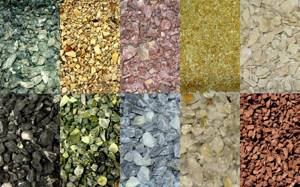
Artificial fractions are multi-colored stones made of plastic or glass, obtained industrially, as well as films that slow down the growth of weeds, geotextiles and other types of bedding. Synthetic fill comes in different sizes and shades, but it is not recommended to fill open ground, since over time it causes soil subsidence.
Did you know? At the turn of the 15th and 16th centuries, the Japanese monk Soami built the world’s most famous rock garden on the territory of a Buddhist temple, which is called “Ryoan-ji” and is included in the UNESCO World Heritage List.
The price of this type of fill is slightly more expensive than organic fill, but due to the neutrality of the chemical composition, it retains its original properties, color and shape throughout its entire service life. Synthetic materials are suitable for designing garden paths and flower beds surrounded by borders. Decorative dry streams, platforms and all kinds of compositions are created from such backfill.
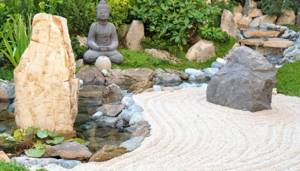
Pebbles
Pebbles are natural stones, which in nature come in two types: sea and river. They are small in size, smooth to the touch and round. If the material is mixed with colored stones, the landscape takes on special colors. Designers prefer to use sea pebbles more often because they look more impressive than river pebbles.
We bring to your attention various types of flower bed designs for landscape design.
If the site has clay or sandy soil, it is necessary to lay out a double amount of material on the paths, because it will sink into the thickness of the soil. To avoid this, the entire path must first be cleared of soil and a bedding made of hard soil.
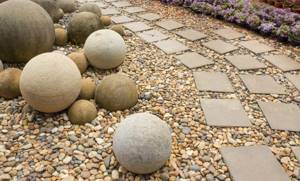
Sand
Fine-grained material is well suited for backfilling when constructing a strip foundation. Sea or river sand is used for the garden. However, they also use the one that remains after processing quartz, marble, shells, granite and expanded clay. As a rule, when creating landscape compositions, a fraction of one rock is used.
Examples of using decorative crushed stone in landscape design
Beautiful stone chips can radically transform the territory of a garden or vegetable garden. The material helps to embody the most daring and original design ideas. The complexity of the work and the type of finishing depend on the tasks set by the landscape designer.
Paths are laid out from decorative crushed stone. For arranging paths, medium-fraction raw materials (2-7 cm) are used. The coating is combined with tiles, wooden cuts or large flat stones. The finish allows moisture to pass through perfectly, which allows you to get rid of puddles.
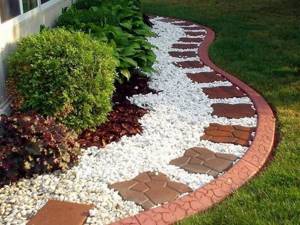
Decorative crushed stone on paths Source stroyobzor.info
Designer gravel is used to create decorative borders along paths. Plain options highlight the beauty of the curve of the path. Drawings (thematic, abstract) and inscriptions made using stencils look impressive on the site. The elements will become a guide to the garden.
Step-by-step recommendations on how to make a gravel flowerbed at your dacha with your own hands
The dacha is a favorite vacation spot for the happy owners of a private house. And if you also have a piece of land, then you can work in between rests. After all, nothing inspires “work that ennobles a person” more than fresh air. In addition to cultivated plants in the garden, every dacha must have a flower garden, and the shape of the flower beds depends only on the imagination of the summer resident. This can be either a simple, unfenced front garden along the fence, or an elaborate flower bed. Recently, a new trend has become increasingly popular - a gravel flowerbed, which practically does not require weeding, since weeds are removed even at the stage of laying the flowerbed.
How to paint crushed stone for landscape design
Natural stones have a limited range of shades. To get an unusual or rich color, designers dye the material. Crushed concrete absorbs pigment most easily. Among natural ones, it is better to use raw materials made of granite, marble or limestone, with a fraction of up to 15 mm.
Gravel for outdoor decoration must be resistant to temperature changes, not leave marks on the snow and not fade under the sun. To tint stones, 5 types of paints are used:
- Enamel PF-115. An atmospheric alkyd mixture based on pentaphthalic varnish is not afraid of climate change. Cons: heavy chemical smell and long drying time (15-24 hours).
- Akrodom-F. The paint retains its characteristics for 6 years. A rich palette allows you to choose the desired shade without tinting.
- AK-511. Road marking agent is used for coloring crushed stone in landscape design. Dries in 120 minutes.
- Acrylic-water dispersion. The substance is suitable for decorating concrete and natural gravel. They are tinted with special pigments. Hardening time – 5 hours.
- Acrylic-styrene. The tint palette is white and yellow, dries 30 minutes after application.
Before painting, crushed stone is sifted through a sieve, carefully inspected and large pieces and foreign additives are removed. The raw materials are washed in a large container with soapy water and rinsed under pressure from a hose. After manipulation, the material is placed on film and dried in the open air for 2 hours.
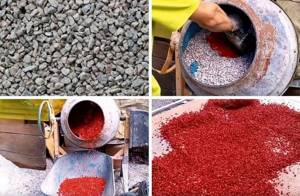
Step-by-step instructions for the procedure Source build73rus.ru
To evenly color the crushed stone, you need to use a concrete mixer. Gravel is loaded into the tank, tinted paint is carefully added and the process is started for 60 minutes. Enamel makes up 20% of the volume of stones. A film or tarpaulin is spread on the ground, onto which the material is poured to dry.
A small amount of crushed stone can be painted in a bucket or deep bowl. The prepared gravel is placed in a container, filled with paint, and thoroughly mixed with a shovel or a handle from garden tools. With a manual procedure, enamel consumption increases by 1.5-2 times.
Step-by-step recommendations for creating a gravel bed
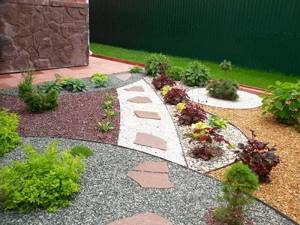
Making a gravel flowerbed at your dacha with your own hands is not that difficult, following the following step-by-step recommendations.
Soil preparation

Select the area where the flowerbed will be laid out and mark its boundaries - drive in pegs and pull the rope. A flower bed with an irregular shape will look more organic. Next, in the designated area, remove the top layer of soil to a depth of 20 cm. Select all the roots in the designated area for the flowerbed. In order not to miss weeds that have not yet sprouted, moisten the area and leave for a week so that they hatch and also remove.
Next, dig up the area. To create a drainage layer when digging, add coarse sand or expanded clay. Then compact the soil a little with a garden roller and cover the dug up area with the first layer of geotextile. It will serve as an obstacle to perennial weeds remaining deep in the ground, and will also keep the gravel from subsidence.
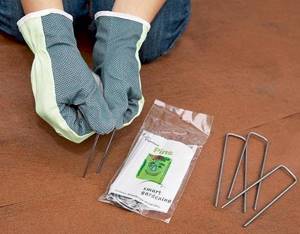
Geotextiles cut into pieces must be laid so that a continuous fabric is obtained. The pieces are fastened together with special degradable fasteners.
After the flowerbed is completely covered with a mulching cloth, every 3 sq.m. you need to pierce holes to drain excess water.
Preparing a place for planting
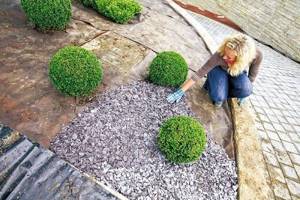
Having decided on the places for planting the plants, they are also cut out in agrofibre, guided by the size of the soft planting containers. Dig a hole in the cut hole, place a container there, fill it with soil and plant the prepared plant. Such containers are very convenient when planting gravel beds, as they protect the root system of flowers or shrubs from damage and separate the planting site from the crushed stone layer.
If the desire to plant new flowers appears after the flowerbed has been filled with gravel, to plant them you must:
- Select crushed stone in the planting area.
- Make a cut in the geotextile and fold the edges down.
- Dig a hole for the seedling.
- Plant the plant, cover it with a small layer of soil, and water it.
- Place the removed gravel back in place.
Filling a flowerbed with gravel

Fill the remaining space after planting with the first layer of gravel. Lay a second layer of geotextile on top and cover with a second decorative layer of gravel.
How to lay crushed stone around trees
Compliance with installation technology will ensure long-term preservation of the decorative characteristics of the material. If preparation is not carried out before the procedure, the gravel will sink into the ground and become overgrown with weeds. The design and color combination are schematically recorded on paper in advance.
In the root circle of the tree, 5-10 cm of the top layer of soil is removed. The soil is leveled, compacted by hand and geotextiles are carefully laid. Agrofibre with a perforated surface will protect against water stagnation under the decor and will not allow weeds to sprout. Sand is evenly distributed over the film, layer thickness is 5 cm.
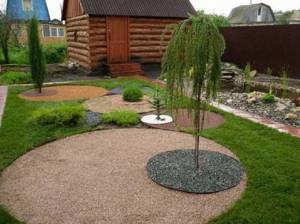
Decorative crushed stone under large plants Source s30668802513.mirtesen.ru
To prevent the coating from spreading, stones or narrow plastic strips are installed along the edges of the circle. Decorative painted crushed stone is poured onto the prepared area. In the design, the background of the root zone is first decorated, then stencils are used to apply a picture or text. Use your hands or a small rake to carefully distribute the material over the surface. Layer thickness – 3-4 cm.
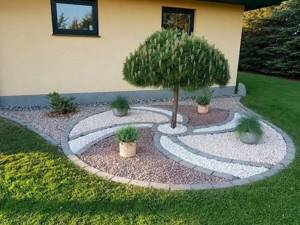
Designer crushed stone under a tree Source yandex.ua
Benefits of a gravel bed
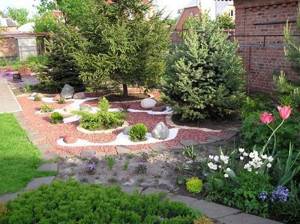
A gravel bed is a mixture of stone and plants, laid and planted in a certain order. This is a small stone garden that confidently outshines simple flower beds due to its advantages:
- requires a minimum of care due to the almost complete absence of weeds, since instead of soil there is a gravel backfill;
- the ability to create flower beds in a variety of places on the site (in the shade, in the sun, on a slope, in blind corners);
- giving any shape and size;
- simple technology for laying out a flower bed;
- no need to frequently water and fertilize planted plants.
